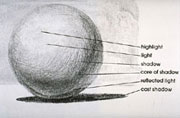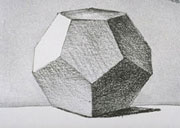
| What is "Light"? | ||
Light, whether natural--from the sun--or artificial, is an element that allows us to see and discern space, volume, and form. The way a light moves across the planes of an object allows us to identify a recognizable form or to experience something previously unknown. The presence of light allows us to see; darkness conceals. We understand forms in the way light moves across and around planes of form. For example, with a sphere, light will only directly hit one point on its surface. As the rest of the surface (an infinite number of planes of form) move in relation to the light, different light conditions result. That is, we perceive different values--different degrees of lightness and darkness. We understand both form and light through a reading of values. |
||
| What does Light do? | . | |
A broad range of values allows for a greater level of descriptiveness. With the sphere, for example, the fine gradations of dark and light indicate multiple, fine planes of form. Contrast the sphere with a hexagon, for example, whose specific planes each manifest a specific value. The clear separation of values allows us to perceive the shift in discrete planes. Manipulating a range of values emphasizes both spatial and textural qualities in both 2D and 3D works. |
||
| . |
||

